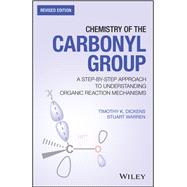Teaches and enables students to build confidence in drawing and manipulating curly arrows, a fundamental skill for all organic chemists
This book is an interactive approach to learning about chemistry of the carbonyl group—inviting students to work through its pages with pencil and paper in hand. It educates with the belief that the most effective way to learn is by practice and interaction. With this in mind, the reader is asked to predict what would happen under a specific set of reaction conditions. The book is divided into frames: each frame poses a question and invites the reader to predict what will happen. Subsequent frames give the solution but then pose more questions to develop a theme further.
Chemistry of the Carbonyl Group: A Programmed Approach to Organic Reaction Mechanisms, Revised Edition provides a solid grounding in the fundamental reactions of carbonyls. Presented in full colour to enhance the understanding of mechanisms within chemistry, the chapters of this step-by-step guide cover: nucleophilic addition to the carbonyl group; nucleophilic substitution; nucleophilic substitution at the carbonyl group with complete removal of carbonyl oxygen; carbanions and enolisation; and building organic molecules from carbonyl compounds.
- A must-have book for undergraduate chemists to emphasise understanding in carbonyl group chemistry
- Goes through all the stages of basic carbonyl chemistry, detailing even the simplest mechanisms
- A step-by-step learning guide to synthetic chemistry for the first year of a chemistry degree, with all the information needed for independent learning
- Provides a solid grounding in the fundamental reactions of carbonyls which will inform the understanding of many other organic chemistry reactions
Chemistry of the Carbonyl Group: A Programmed Approach to Organic Reaction Mechanisms - Revised Edition is packed with all the information on synthetic chemistry that every first-year student will need in order to learn independently.








